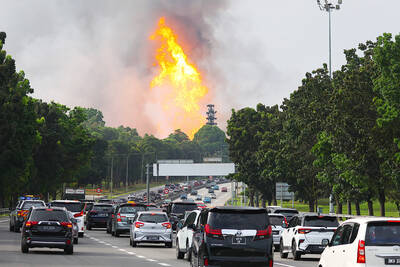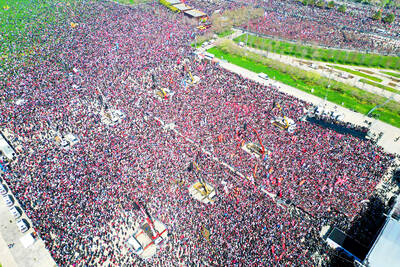The US could get a major trade boost from the soon-to-be-finished expansion of the Panama Canal, but experts worry poor infrastructure means Uncle Sam will miss the boat.
From 2014, some of the largest ships in the world will again fit through the 80km Panama Canal. Vessels carrying about 14,000 containers rather than today’s 5,000 will be able to cross the isthmus.
Traffic is expected to double through the inter-oceanic waterway, which already handles about 5 percent of world trade.
For people linked via the canal — most notably consumers in the eastern US and factory owners in China — that could spell cheaper goods and lower costs.
It could also provide US President Barack Obama with a late boost in his effort to double US exports by 2015 and help create jobs.
In Florida alone, the authorities believe upgrading the Port of Miami to handle these larger ships could help create 30,000 jobs.
However, during a visit to Washington last week the canal’s administrator Alberto Aleman Zubieta expressed concern that the US is not ready.
“There is a lot of infrastructure that basically needs to be upgraded,” he said, pointing to problems with dock length, port depth and rail and road links.
Like much of the US’ infrastructure, its ports are creaking from years of underinvestment and many even struggle to handle today’s largest “panamax” ship sizes.
“We don’t have the channel depths that are required to take the post-panamax vessels,” said Dave Sanford, of the American Association of Port Authorities.
The list of ports that do, he said, “is really short. It’s only one port: Norfolk [Virginia].”
While Baltimore, New York and Miami may also be ready by 2014, they handle a fraction of US trade and are not on the Gulf Coast, which serves consumers and exporters in the vast center of the US.
Perched on the meandering Mississippi, the Port of New Orleans is one of many facilities that has struggled to match infrastructure to its opportunities.
It is investing US$650 million on new canal-linked projects, mostly on container terminals, but chief executive Gary LaGrange said the port is still not at fighting weight.
“We’ll be ready, but not as ready as we could be, or should be,” he said.
Blame for the -unpreparedness is being spread far and wide: Former US president George Washington, the Army Corp of Engineers and Congress are all in the firing line.
Since Washington’s time the US Army has played a role ensuring waterways are navigable.
Even today, the Army Corps of Engineers — with one eye on its own limited budget and resources — must approve and execute many upgrades.
Congress, which is currently focused on cutting US debt, then has to approve funding.
That results in significant delays, according to many in the industry.
LaGrange said New Orleans already holds much sought-after permission to dredge its channel to 15m — enough to handle post-panamax ships.
However, bureaucracy means the project is on the back burner.
“Right now it is everything we can do to get the Corp of Engineers to maintain it at its current 47 foot [14.3m] depth,” he said.
Similarly, the Port of Beaumont, Texas, is waiting for approval of a US$1.2 billion project to deepen its channel, but even if the project is approved this year, it is likely to take 15 years to complete.
“Our system is broken, it’s just broken. It needs to be fixed,” said John Roby, head of the port’s customer services.
In the meantime, shippers are looking to deeper ports beyond the US; to Freeport in the Bahamas and Kingston in Jamaica.
“Unless we can get more channel capacity, they are going to be the primary beneficiaries of an expanded canal,” Sanford said.
Ultimately, that may cost US consumers.
“If you can’t take advantage of the economies of scale that the larger vessels offer,” said Paul Bingham, an economist with Wilbur Smith Associates, “the bottom line is it’s going to cost you more. For the economy that ultimately means that the consumers are going to be worse off.”

A fire caused by a burst gas pipe yesterday spread to several homes and sent a fireball soaring into the sky outside Malaysia’s largest city, injuring more than 100 people. The towering inferno near a gas station in Putra Heights outside Kuala Lumpur was visible for kilometers and lasted for several hours. It happened during a public holiday as Muslims, who are the majority in Malaysia, celebrate the second day of Eid al-Fitr. National oil company Petronas said the fire started at one of its gas pipelines at 8:10am and the affected pipeline was later isolated. Disaster management officials said shutting the

US Vice President J.D. Vance on Friday accused Denmark of not having done enough to protect Greenland, when he visited the strategically placed and resource-rich Danish territory coveted by US President Donald Trump. Vance made his comment during a trip to the Pituffik Space Base in northwestern Greenland, a visit viewed by Copenhagen and Nuuk as a provocation. “Our message to Denmark is very simple: You have not done a good job by the people of Greenland,” Vance told a news conference. “You have under-invested in the people of Greenland, and you have under-invested in the security architecture of this

Japan unveiled a plan on Thursday to evacuate around 120,000 residents and tourists from its southern islets near Taiwan within six days in the event of an “emergency”. The plan was put together as “the security situation surrounding our nation grows severe” and with an “emergency” in mind, the government’s crisis management office said. Exactly what that emergency might be was left unspecified in the plan but it envisages the evacuation of around 120,000 people in five Japanese islets close to Taiwan. China claims Taiwan as part of its territory and has stepped up military pressure in recent years, including

UNREST: The authorities in Turkey arrested 13 Turkish journalists in five days, deported a BBC correspondent and on Thursday arrested a reporter from Sweden Waving flags and chanting slogans, many hundreds of thousands of anti-government demonstrators on Saturday rallied in Istanbul, Turkey, in defence of democracy after the arrest of Istanbul Mayor Ekrem Imamoglu which sparked Turkey’s worst street unrest in more than a decade. Under a cloudless blue sky, vast crowds gathered in Maltepe on the Asian side of Turkey’s biggest city on the eve of the Eid al-Fitr celebration which started yesterday, marking the end of Ramadan. Ozgur Ozel, chairman of the main opposition Republican People’s Party (CHP), which organized the rally, said there were 2.2 million people in the crowd, but